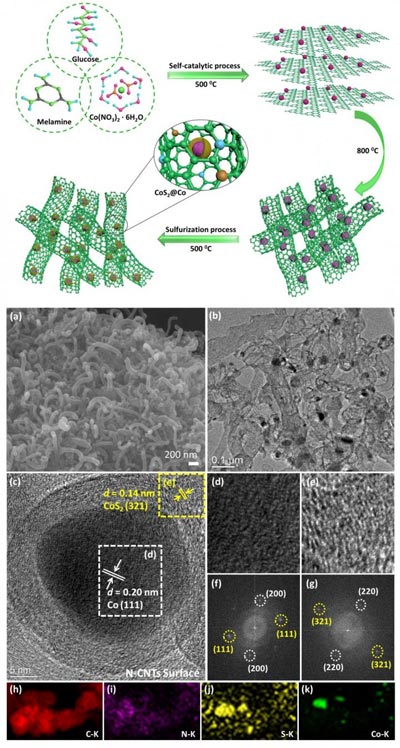S, N co-doped carbon nanotube-encapsulated CoS2@Co

Schematic illustration and physical characterization of S, N co-doped carbon nanotubes encapsulated core-shell (CoS2@Co) nanoparticles. Credit: ©Science China Press
Electrochemical water splitting is favorable strategy to produce high-purity H2. The current mainstream catalysts for water electrolysis are precious metals (Pt, RuO2, IrO2), which possess superior catalytic activity, relatively low over-potential and favorable catalytic kinetics, but their high cost and poor cycle stability is still unaffordable.
Therefore, it is urgent to develop a new type of hydrogen production catalyst with low cost, high catalytic activity and high stability.
Due to its low cost, high abundance, and good electrical conductivity, the transition metal-Co and its derivatives have shown great promise in electrocatalysis.
However, stability has been a big issue due to their high chemical activities. To address this issue, encapsulation of Co nanoparticles into carbon shell has been proposed as an effective strategy to inherit the high electrocatalytic activity of the transition metal, and further prevent its corrosion from the harsh electrolytic environment.
By tuning the metal composition and structure of carbon layers, the catalytic properties of these composites can be regulated.
Recently, Liu Zhao-Qing's group of Guangzhou University reports a bifunctional catalyst, transition metal cobalt ions induced the self-growth of nitrogen doped carbon nanotubes, which are further vulcanized to incorporate sulfur into the carbon nanotubes framework.
The obtained materials (S, N-CNTs/CoS2@Co) exhibit excellent HER and OER performance. As cathode and anode, S, N-CNTs/CoS2@Co can rapidly dissociate water molecules to produce hydrogen and oxygen gases, requiring only 1.633 V to reach a current density of 10 mA cm-2, and a strong stability under various operating currents is also observed.
###
See the article:
Jing-Yu Wang, Ting Ouyang, Nan Li, Tianyi Ma, Zhao-Qing Liu. S, N co-doped carbon nanotube-encapsulated core-shelled CoS2@Co nanoparticles: efficient and stable bifunctional catalysts for overall water splitting, Science Bulletin, 2018, DOI: 10.1016/j.scib.2018.07.008.
https:/
Media Contact
More Information:
http://dx.doi.org/10.1016/j.scib.2018.07.008All latest news from the category: Life Sciences and Chemistry
Articles and reports from the Life Sciences and chemistry area deal with applied and basic research into modern biology, chemistry and human medicine.
Valuable information can be found on a range of life sciences fields including bacteriology, biochemistry, bionics, bioinformatics, biophysics, biotechnology, genetics, geobotany, human biology, marine biology, microbiology, molecular biology, cellular biology, zoology, bioinorganic chemistry, microchemistry and environmental chemistry.
Newest articles

Detector for continuously monitoring toxic gases
The material could be made as a thin coating to analyze air quality in industrial or home settings over time. Most systems used to detect toxic gases in industrial or…

On the way for an active agent against hepatitis E
In order to infect an organ, viruses need the help of the host cells. “An effective approach is therefore to identify targets in the host that can be manipulated by…

A second chance for new antibiotic agent
Significant attempts 20 years ago… The study focused on the protein peptide deformylase (PDF). Involved in protein maturation processes in cells, PDF is essential for the survival of bacteria. However,…





















